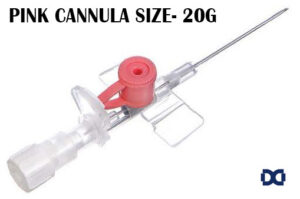In the intricate dance of medical procedures, every detail matters. Among the essential tools utilized in healthcare, IV cannulas are pillars of intravenous therapy, facilitating swift and efficient delivery of fluids and medications. Within this realm, the size of the cannula emerges as a critical factor, dictating both the efficacy of treatment and patient comfort. This comprehensive exploration delves into the specific specifications of pink cannulas, such as Pink Cannula Size and pink cannula flow rate, shedding light on their crucial role and implications in medical practice.
Understanding IV Cannulas:
At the heart of intravenous therapy lies the IV cannula, a slender tube designed for the insertion into veins to administer fluids or medications directly into the bloodstream. This procedure, known as intravenous cannulation, is a cornerstone of modern medical practice, enabling rapid and precise delivery of therapeutic agents.
Significance of IV Cannula Size:
The size of an IV cannula, often denoted by its gauge, holds paramount importance in clinical settings. The indicator corresponds to the diameter of the cannula, with larger meters allowing for a higher flow rate of fluids and medications. Conversely, smaller gauges offer slower flow rates, which may be preferable in certain situations to minimize patient discomfort and vascular trauma.
Read Alos: A Comprehensive Guide: IV Cannula Sizes,Colors, Flow Rates and Usage
Pink Cannula Size, Flow Rate & Diameter
Pink cannulas, characterized by their intermediate gauge size, occupy a unique po sition in the spectrum of IV cannulas. Pink cannula size typically corresponds to a gauge size 20, although slight variations may exist depending on the manufacturer. The gauge size directly influences the flow rate of fluids and medications administered through the cannula, as well as the ease of insertion and patient comfort. The flow rate of a pink cannula averages 54 ml/min, ensuring efficient delivery of fluids and medications. Additionally, the length of a standard pink cannula measures approximately 32 mm, providing adequate reach for venous access while minimizing the risk of complications.
sition in the spectrum of IV cannulas. Pink cannula size typically corresponds to a gauge size 20, although slight variations may exist depending on the manufacturer. The gauge size directly influences the flow rate of fluids and medications administered through the cannula, as well as the ease of insertion and patient comfort. The flow rate of a pink cannula averages 54 ml/min, ensuring efficient delivery of fluids and medications. Additionally, the length of a standard pink cannula measures approximately 32 mm, providing adequate reach for venous access while minimizing the risk of complications.
Optimizing Flow Rate and Comfort:
The flow rate of a cannula directly influences the speed and efficacy of treatment administration. With their moderate gauge size and optimized flow rate of 54 ml/min, Pink cannulas offer a versatile solution for a wide range of clinical scenarios. Whether administering fluids for hydration, medications for pain relief, or blood products for transfusion, healthcare providers can rely on pink cannulas to deliver therapeutic agents efficiently while prioritizing patient comfort.
Clinical Applications:
Pink cannulas find extensive utility across various medical specialties and settings. In emergency medicine, they excel in rapid fluid resuscitation during critical situations, thanks to their optimal flow rate and ease of insertion. Similarly, pink cannulas are indispensable in surgical settings for perioperative fluid management and medication administration, ensuring smooth transitions and optimal patient outcomes.
Pediatric Considerations:
The use of IV cannulas in pediatric patients necessitates special considerations due to their unique physiology and vulnerability. With their intermediate gauge size and gentle flow rate, pink cannulas are well-suited for pediatric use, minimizing discomfort and tissue trauma during insertion. Moreover, the standardized length of pink cannulas ensures compatibility with pediatric anatomy, facilitating safe and effective venous access in young patients.
Read Also: Mastering Pediatric IV Cannulation: A Comprehensive Guide
Quality Assurance:
As a leading manufacturer of medical devices, Denex International prioritizes stringent quality control measures to uphold the highest safety and performance standards. Each pink cannula undergoes rigorous testing to ensure dimensional accuracy, material integrity, and sterility, instilling confidence in healthcare providers and patients.
Future Directions:
As medical technology advances and clinical practices evolve, IV cannulation’s landscape continues to transform. Innovations in material science, design, and manufacturing processes promise to enhance IV cannulas’ performance and comfort further. Additionally, ongoing research endeavors aim to refine cannula sizing algorithms and insertion techniques, paving the way for even greater precision and efficiency in intravenous therapy.
Conclusion:
In conclusion, pink cannulas embody a delicate balance between efficiency and comfort in intravenous therapy. With their intermediate gauge size, optimized flow rate, and standardized dimensions, pink cannulas offer healthcare providers a reliable tool for delivering fluids and medications while prioritizing patient well-being. As a trusted partner in healthcare, Denex International remains committed to advancing the field of intravenous therapy through innovative products and unwavering dedication to quality and safety.







